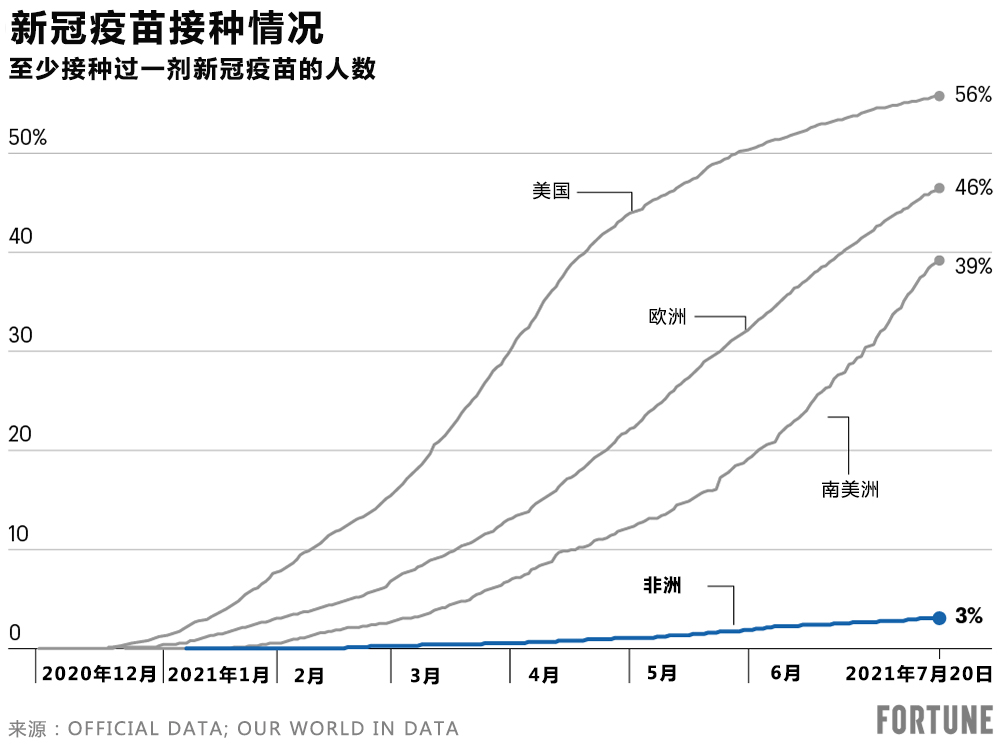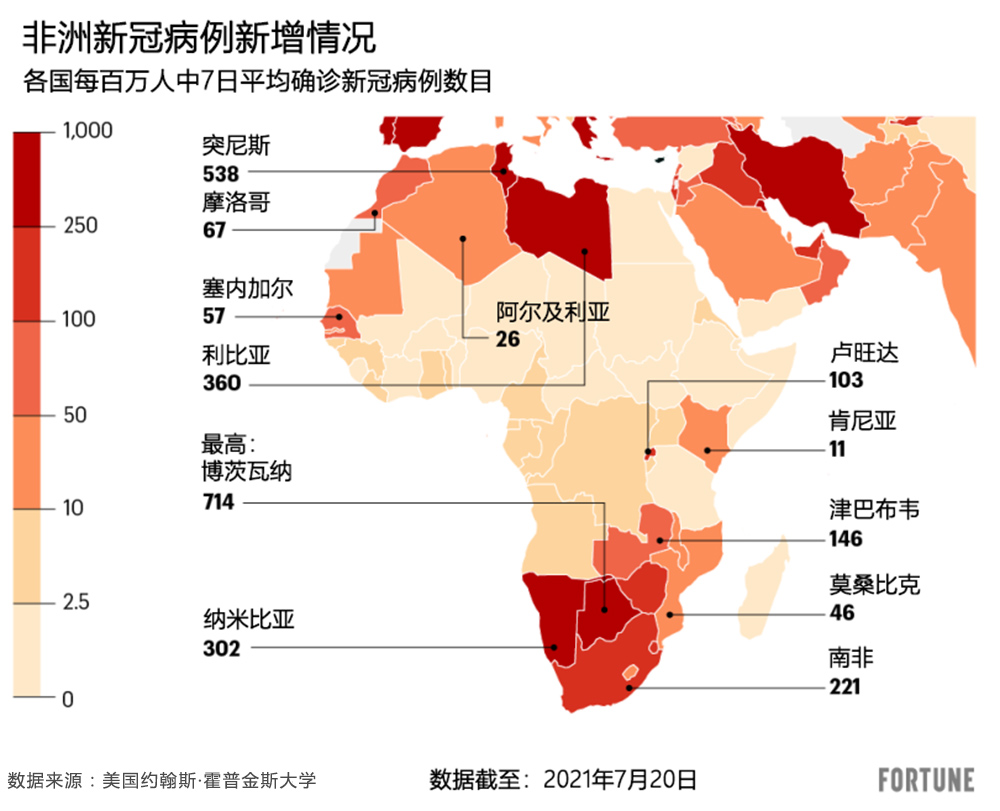辉瑞将于2022年在非洲生产新冠疫苗
今年7月22日,传来了一个好消息:辉瑞(Pfizer)及其合作伙伴BioNTech将开始在非洲生产新冠疫苗,目的正是供应非洲市场。这个发展令人欢欣鼓舞。非洲人口占全球人口的17%以上,但根据世界卫生组织(World Health Organization)的数据,到目前为止,非洲获得的新冠疫苗数量只占全球供应量的1.7%。根据收集地方政府信息的组织Our World in Data的数据,截至7月20日,非洲只有3%的人口注射了一剂或两剂新冠疫苗。
在辉瑞宣布这一消息之际,国际形势正处于非常紧迫的状态。尽管非洲国家在新冠疫情的早期阶段管理相对良好,但在过去9周内,其新增新冠肺炎病例数目出现了激增——德尔塔变种等传染性更强的病毒株在非洲的传播难辞其咎。非洲大陆北部以及南部,尤其是利比亚和突尼斯、博茨瓦纳和纳米比亚,都出现了病例激增的情况。在过去7天里,这些国家平均每天每百万人中就有300多例新病例。

据世界卫生组织的数据,上周整个非洲大陆的新增病例略有下降(下降了1.7%,至28.2万人),但这在很大程度上归功于南非情况的改善。除南非外,整个非洲大陆的新增病例在过去一周内增加了18%,比之前的峰值高出80%。
此外,有21个非洲国家在过去两周内的新增病例数量分别增长了20%以上。
世界卫生组织非洲区域主任马希迪索•莫蒂博士在7月23日发表的一份声明中说:“不要抱有任何侥幸心理,非洲的第三波疫情绝对尚未结束。许多国家的风险指数仍然处于峰值。”

与此同时,新冠疫苗在非洲的推广却处于相当早期的阶段。7个非洲国家对其人口提供至少一种新冠疫苗的比例不到1%;另外23个国家的疫苗提供比例也不及5%。毛里求斯是接种疫苗最多的非洲岛国,有47.82%的人口接种了疫苗;摩洛哥紧随其后,约31%的人口已经注射了至少一剂疫苗。
目前的问题不是需求,而是供应。虽然将有疫苗送入非洲(6000万疫苗将在未来几周抵达非洲国家),但这还不够及时。世界卫生组织报告称,到今年年底,新冠肺炎疫苗实施计划(COVAX)将向非洲大陆提供5亿多剂疫苗。
辉瑞与BioNTech将与南非公司Biovac合作,在非洲生产疫苗,但是要到2022年才会投产。一旦全面投产,这一项目每年将生产超过1亿支疫苗。
7月22日,辉瑞的首席执行官艾伯乐(Albert Bourla)在谈到这一计划时称:“从第一天起,我们的目标就是为世界各地的每个人提供公平、公正合理的新冠疫苗。”
南非的Biovac公司首席执行官莫雷娜•马克阿纳博士则表示,这一进展是“在抗击这一悲剧性的全球疫情的斗争当中,在加强获得疫苗的可持续渠道方面迈出的关键一步”。
美国乐施会(Oxfam America)的高级宣传经理、人民疫苗联盟(People’s Vaccine Alliance)的发言人罗比•西尔弗曼认为辉瑞公司的计划是“好消息”。但他指出,就现如今辉瑞的绝大多数疫苗分发的去向而言,“这根本不够”。(财富中文网)
编译:杨二一
今年7月22日,传来了一个好消息:辉瑞(Pfizer)及其合作伙伴BioNTech将开始在非洲生产新冠疫苗,目的正是供应非洲市场。这个发展令人欢欣鼓舞。非洲人口占全球人口的17%以上,但根据世界卫生组织(World Health Organization)的数据,到目前为止,非洲获得的新冠疫苗数量只占全球供应量的1.7%。根据收集地方政府信息的组织Our World in Data的数据,截至7月20日,非洲只有3%的人口注射了一剂或两剂新冠疫苗。
在辉瑞宣布这一消息之际,国际形势正处于非常紧迫的状态。尽管非洲国家在新冠疫情的早期阶段管理相对良好,但在过去9周内,其新增新冠肺炎病例数目出现了激增——德尔塔变种等传染性更强的病毒株在非洲的传播难辞其咎。非洲大陆北部以及南部,尤其是利比亚和突尼斯、博茨瓦纳和纳米比亚,都出现了病例激增的情况。在过去7天里,这些国家平均每天每百万人中就有300多例新病例。
据世界卫生组织的数据,上周整个非洲大陆的新增病例略有下降(下降了1.7%,至28.2万人),但这在很大程度上归功于南非情况的改善。除南非外,整个非洲大陆的新增病例在过去一周内增加了18%,比之前的峰值高出80%。
此外,有21个非洲国家在过去两周内的新增病例数量分别增长了20%以上。
世界卫生组织非洲区域主任马希迪索•莫蒂博士在7月23日发表的一份声明中说:“不要抱有任何侥幸心理,非洲的第三波疫情绝对尚未结束。许多国家的风险指数仍然处于峰值。”
与此同时,新冠疫苗在非洲的推广却处于相当早期的阶段。7个非洲国家对其人口提供至少一种新冠疫苗的比例不到1%;另外23个国家的疫苗提供比例也不及5%。毛里求斯是接种疫苗最多的非洲岛国,有47.82%的人口接种了疫苗;摩洛哥紧随其后,约31%的人口已经注射了至少一剂疫苗。
目前的问题不是需求,而是供应。虽然将有疫苗送入非洲(6000万疫苗将在未来几周抵达非洲国家),但这还不够及时。世界卫生组织报告称,到今年年底,新冠肺炎疫苗实施计划(COVAX)将向非洲大陆提供5亿多剂疫苗。
辉瑞与BioNTech将与南非公司Biovac合作,在非洲生产疫苗,但是要到2022年才会投产。一旦全面投产,这一项目每年将生产超过1亿支疫苗。
7月22日,辉瑞的首席执行官艾伯乐(Albert Bourla)在谈到这一计划时称:“从第一天起,我们的目标就是为世界各地的每个人提供公平、公正合理的新冠疫苗。”
南非的Biovac公司首席执行官莫雷娜•马克阿纳博士则表示,这一进展是“在抗击这一悲剧性的全球疫情的斗争当中,在加强获得疫苗的可持续渠道方面迈出的关键一步”。
美国乐施会(Oxfam America)的高级宣传经理、人民疫苗联盟(People’s Vaccine Alliance)的发言人罗比•西尔弗曼认为辉瑞公司的计划是“好消息”。但他指出,就现如今辉瑞的绝大多数疫苗分发的去向而言,“这根本不够”。(财富中文网)
编译:杨二一
On July 22, brought the good news that Pfizer and its partner BioNTech would start manufacturing its COVID-19 vaccines in Africa, for Africa. That’s a welcome development in a part of the world that is home to more than 17% of the planet’s population but so far, has received only 1.7% of the global supply of coronavirus vaccines according to the World Health Organization. Through July 20, just 3% of Africa’s population has received at least one COVID shot according to Our World in Data, which collects information from local governments.
Pfizer’s announcement arrived at a time when the urgency couldn’t be clearer. After managing the early phases of the pandemic relatively well, African countries for the past nine weeks have been battling surging new COVID case numbers due to the spread of more transmissible virus strains like the Delta variant. Cases have exploded in the North and South of the continent, particularly in Libya and Tunisia, and Botswana and Namibia respectively; each of those countries has an average of more than 300 new cases per day per million people for the past seven days.
While the number of new cases dipped slightly last week for the whole continent—down by 1.7% to 282,000 according to the World Health Organization—that is largely due to the improving situation in South Africa. Excluding South Africa, numbers across the continent increased 18% over the past week, and are 80% higher than what they were at the previous peak.
According to the WHO, 21 African countries have seen cases rise by over 20% for each of the past two weeks.
“Be under no illusions, Africa’s third wave is absolutely not over,” said Dr. Matshidiso Moeti, WHO’s Regional Director for Africa, in a statement issued on July 23. “Many countries are still at peak risk.”
The vaccine rollout, meanwhile, is of course in the very early stages. Seven African countries have yet to reach 1% of their populations with at least one COVID vaccine; another 23 are below 5%. The island of Mauritius is furthest along with 47.82% of its population vaccinated; Morocco comes next with about 31% of its population having gotten one shot.
The problem at the moment is not demand, but supply. While more vaccines are coming—60 million vaccines are due to arrive for African countries in the coming weeks—it’s not soon enough. The WHO reports COVAX will have delivered more than 500 million doses to the continent by the end of the year.
The African-manufactured Pfizer and BioNTech vaccines, which will be produced in collaboration with the South African firm Biovac, won’t roll off the lines until 2022. The effort will produce more than 100 million vaccines per year once it’s operating at full capacity.
“From day one, our goal has been to provide fair and equitable access of the Pfizer-BioNTech COVID-19 Vaccine to everyone, everywhere,” Pfizer CEO Albert Bourla said about the effort on July 22.
Dr. Morena Makhoana, CEO of South Africa’s Biovac described the development as “a critical step forward in strengthening sustainable access to a vaccine in the fight against this tragic, worldwide pandemic.”
Robbie Silverman, Oxfam America’s Senior Advocacy Manager and spokesperson for the People’s Vaccine Alliance, called Pfizer’s announcement “good news,” but noting where the vast majority of the company’s vaccines had been distributed so far added, “It is simply not enough.”













